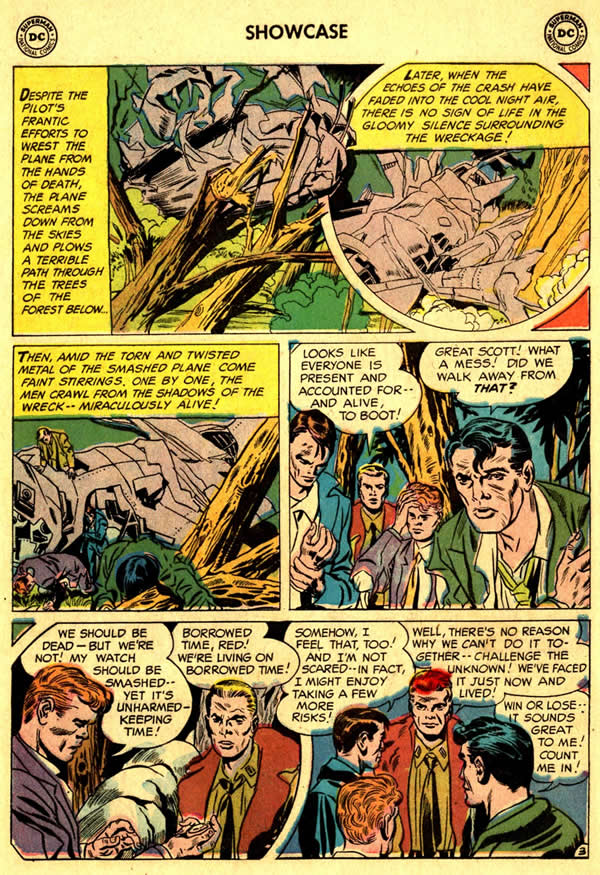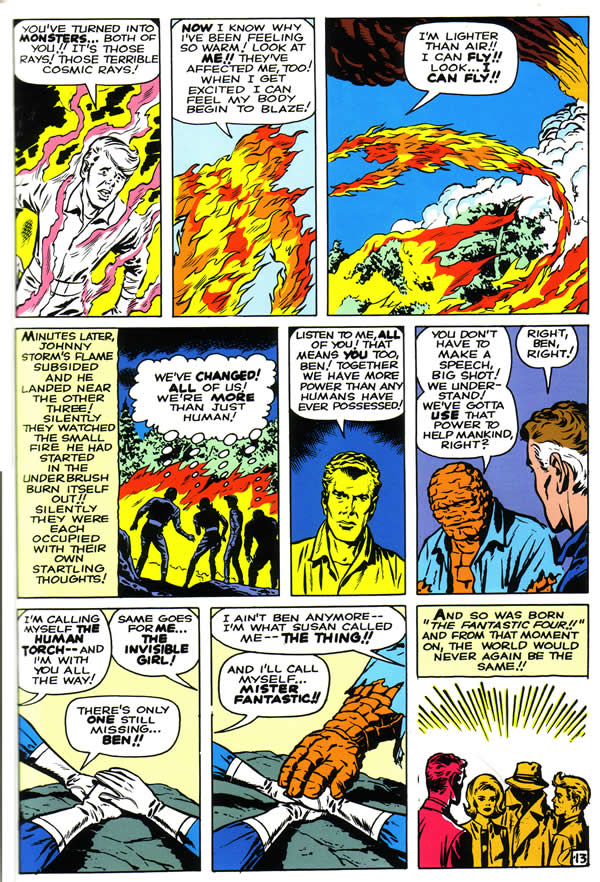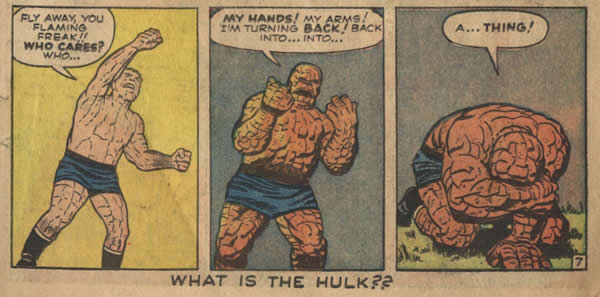“The World’s Greatest Comic Magazine.” What a mouthful of hyperbole. And yet once this claim was made, it rapidly became a self-fulfilling prophecy. The origins of the comic that changed the face of comics are fairly well documented, and yet the story is full of uncertainties and conflicting testimony. Consensus generally accepts the account that Marvel’s publisher Martin Goodman wanted a super hero comic book to match the success of DC Comics’ latest hit, The Justice League of America. The year was 1961, and Goodman had been publishing a series of comics featuring monsters with names such as Fin Fang Foom and Gorgilla. The lead story was generally written by Stan Lee and drawn by Jack Kirby. Goodman approached his editor and chief writer, Stan Lee to come up with his superhero team. According to Lee, the writer prepared a synopsis and presented it to artist Jack Kirby.
Here, we have our first conflict. Jack Kirby, as you probably already know, was an artist gifted with one of the greatest imaginations in the history of comics or for that matter fantasy literature. Any story Kirby may have drawn has almost certainly been at least partially plotted by him. Kirby’s method of working has been described by Kirby historian, Mark Evanier, in his book “Kirby, King of Comics”, describing a strip called, Challengers of the Unknown.
“Dave Wood provided scripts, which pretty much meant sitting with Kirby, hearing him spin off a plot and then going home and typing it up. Jack rewrote whatever he was given anyway.”
Stan Lee would eventually describe his style of working with Kirby as the origin of what became known as “The Marvel Method”. Lee discovered that working with an artist as imaginative as Kirby made it possible for him to provide Kirby with the bare minimum of plot details, in order to generate a story. Lee would begin the process by giving the artist a story outline. After he received the completed story from Kirby, including Kirby’s margin notes Lee would fill in the dialog.
We can have no idea when Lee began working this way with Kirby. Fairly recently, he has unearthed a synopsis for the FF’s first issue to verify his initial creation of the concept, which could just as well have been written after a story conference with Kirby.
What makes the story more convoluted and interesting is the similarity both in look and origin between the Fantastic Four and the first appearance of The Challengers of The Unknown, a comic book that Kirby had done several years earlier for DC comics. The premise of the book is the story of four adventurers who band together, after they realize that they are living on borrowed time.
Here is a page showing the group making a vow just after their plane has crashed. This origin sequence bears a striking resemblance to that of the Fantastic Four. There is obviously a good deal of Kirby’s creative input in the Four’s creation.
In both stories, the four adventurers crash their plane or rocket in the woods. Then, they stand in a circle and pledge themselves to a cause as a team. The Challengers will later dress in purple jump suits, which are similar to the outfits that the Fantastic Four are wearing when their rocket ship crashes after an unsuccessful journey to outer space.
The strangest thing about the Fantastic Four is probably the circumstances that brought about their creation, which essentially sets them apart from nearly every other superhero team, and very likely had little to do with Lee or Kirby. It is the fact that Martin Goodman’s company was doing fairly well publishing several comics that featured monsters as their stars. We can then surmise that the decision to include a monster in the line-up of the Fantastic Four was based on the fact that Goodman was hedging his bets. He had decided to take the plunge with a superhero comic, but to assure that he retained his core audience, he probably instructed Lee and Kirby to include a monster among the leading characters.
Ironically, this strange decision was responsible for the success of the Fantastic Four and indeed it could be argued, for the entire Marvel line. Because of the Thing’s monstrous condition, an obvious conflict was created. Ben Grimm’s resentment was the catalyst for the entire concept of heroes with problems. Gradually, the Thing began to evolve, to grow and learn to deal with his issues, but not before a good deal of emotional trauma and tension within the group. Ben would continually be tortured by being unexpectedly transformed back and forth, from his human self to the Thing, as in this segment from FF#4. Notice the beauty of this transition as an enraged Ben Grimm shakes his fist at the retreating Human Torch, until, suddenly aware of his transformation in the second panel, he sinks to the ground in the third frame, overcome with grief.
So, in essence, we have here a fairly ordinary team of heroes, whose powers for the most part have been seen before. A man with stretching abilities is certainly not an original concept, nor is an invisible woman. The Human Torch is a retread of a Golden Age character. It is only with the introduction of a monster that the literal wild card is revealed. It seems that it is nearly irrelevant who specifically created the Fantastic Four. It is clear that the fates created the Fantastic Four by putting in place the circumstances in which such a concept could bear fruit. Goodman, Kirby and Lee are all responsible, but in the end it is the unique creative abilities that were unleashed in the moment that make the idea into so much more than its humble origins could provide.
The series becomes a springboard for some of the wildest concepts ever to be seen, in and out of comics, as the four heroes try to cope with a changing world. The cosmic sixties was the perfect time for them to evolve. Here, we see our four heroes staring out at Galactus, in shock and awe. The expression on their faces might just as well been on ours, confronting the uncertainties and yet also the wonders that faced us in that wild decade. I for one felt more secure in that moment, having spent much of that time of magic and mystery engrossed in the World’s Greatest Comic Magazine.
Image 1 – Showcase #6 Challengers of the Unknown, Jack Kirby, Dave Wood, DC Comics
Image 2 – Fantastic Four #1 Jack Kirby, Stan Lee, Marvel Comics
Image 3 – Fantastic Four #4 Jack Kirby, Stan Lee, Marvel Comics
Image 4 – Fantastic Four #49 Jack Kirby, Stan Lee, Marvel Comics





